Click on our logo above to view how you can increase visits
to your website using one of our advertising options.
 |
Leucadendron salignum (Golden Tip) is the most widespread species of the family Proteaceae, occurring in a large part of South Africa and on a wide range of soil types, from sea level to an altitude of 2000 m and is quite variable in leaf size as well as leaf- and bract colour. Leucadendrons are dioecious, i.e. separate male and female plants, which is unusual in the protea family. Its long flowering season (May - Dec), coupled with colourful leaves and bracts surrounding the flowers, make this species an attractive garden plant.
Leucadendron salignum is a multi-stemmed shrub with a persistent rootstock, which enables it to resprout after fire. In its natural conditions it grows to a height of 0.75 to 2 m. The variability of growing conditions, from mild winter temperatures to snow and frost near mountain tops, as well as the variability of leaves and bracts, from greenish-yellow to vivid orange-red, have made this species an excellent candidate for breeding. In addition, this species adapts well to vigorous pruning, which makes it suitable for the production of cut foliage on a large scale.
This beautiful flower colours most of the Fernkloof Nature Reserve in a yellow blanket, giving the mountain a constant glow.
Bean, A & Johns, A (2005). Stellenbosch to Hermanus: South African Wild Flower Guide 5. Cape Town: Botanical Society of South Africa. 164 -165
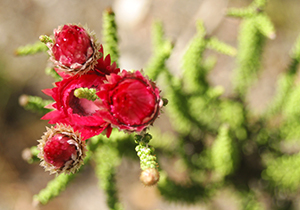 |
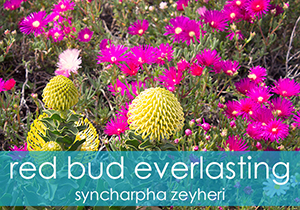 |
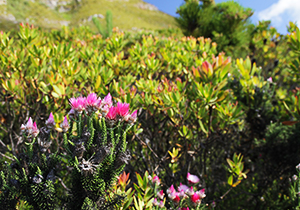 |
The Syncharpha Zeyheri is a sturdy shrublet that grows to an average of 20cm in height. It’s most noticeable features are the felt-like leaves that cover most of the stem, becoming smaller near the flower heads/blossoms. You can usually find several blossoms grouped together on stems, with each head being a small scattered rosy bract, which become larger and more crowded as they grow. These flowers occur from the Cape Peninsula to #Hermanus on grassy and rocky flats and slopes between August and October.
The flower is known as an everlasting due to its ability to survive without nutrients for several weeks before wilting. This is because of the lack of water absorbing petals and leaves, all of which have adapted to a harsher, drier climate. Therefore they are a popular choice for flower bouquets and displays.
Bean, A & Johns, A (2005). Stellenbosch to Hermanus: South African Wild Flower Guide 5. Cape Town: Botanical Society of South Africa. 290 - 291.
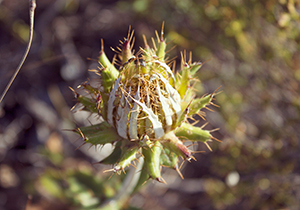 |
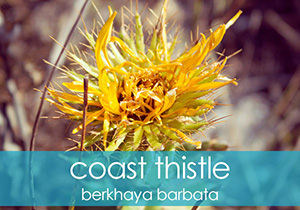 |
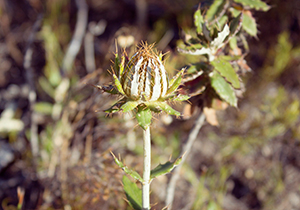 |
The Berkheya Barbata or Coast Thistle is a beautiful sunflower-like bloom but it’s a nightmare to touch. The leaves are bordered by long, thin thorns whilst the stems and bracts hamper its potential as a cut-flower.
This Thistle is a perennial and can grow up to 60cm in height. Plants produce numerous stems to form a dense and entangled shrub that can be found along and over rocks and other vegetation. The younger leaves are usually covered by a protective cotton-like layer that rub off as the plant matures. The leaves themselves are arranged in pairs, up to 60mm long and 25mm wide, bright green and glossy above with white, dense hairy cover below.
The flower heads can sometimes grow to the size of a hand (around 100mm in diameter) and have an outer ring of bright yellow to orange-yellow petals and a matching centre. At the end of the flower’s lifespan, the spiny bracts that cover the plant create a protective layer for the seeds.
These flowers can be found in harsh, coastal areas as well as in deep sands, rocky outcrops and along cliffs.
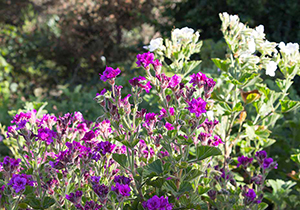 |
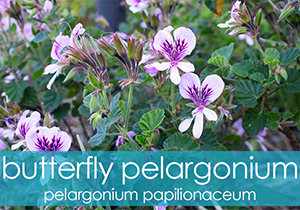 |
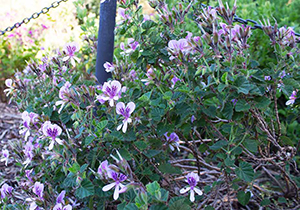 |
Pelargonium Papilionaceum is part of the Geraniaceae Family (The Geranium Family), which is known for its varying and colourful buds.
The Pelargonium Papilionaceum is also known as the Butterfly Pelargonium Rambossie, which is an erect, soft and unpleasantly scented shrub that grows to around 2 meters in height. It has a woody main trunk, shaped on upper part and around 10 cm across. The long-stalked flowers, grouped in clusters of 5 – 12 are around 3cm across. It grows in partly shady kloofs and at the edges of forests from Stellenbosch to the Klein River Mountains from around August until January.
These plants are also very popular in gardens, and can be found in Fernkloof and the Fernkloof Gardens in great numbers.
Bean, A & Johns, A (2005). Stellenbosch to Hermanus: South African Wild Flower Guide 5. Cape Town: Botanical Society of South Africa. 210 - 211
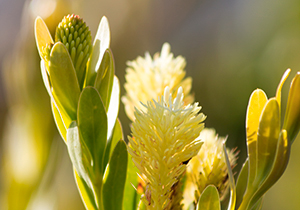 |
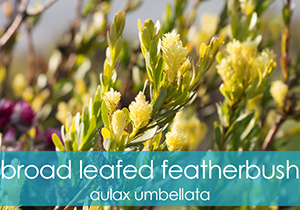 |
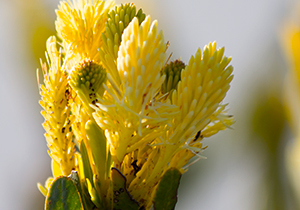 |
The Broad Leafed Featherbush, scientifically known as the Aulax Umbellata of the Protea family, is a slender shrub grows up to 2.5 meters tall, with bright yellow flowers blooming against purplish brown younger foliage from November to February.
The plants of the genus Aulax are dioecious, with separate male and female plants. The flowers of the male plants are bright lemon yellow, arranged in small lax spikes, which open over a period of several weeks. The new leaves of some of the plants are a beautiful purplish brown from early September, slowly fading to green after the end of the flowering period. The leaves of Aulax umbellata are more or less needle shaped, but considerably wider than the other two species, and this is the main distinguishing characteristic for the species.
The inflorescence morphology and systematics of Aulax (Proteaceae) by J.P. Rourke, S. Afr. J. Bot., 1987, 53(6).